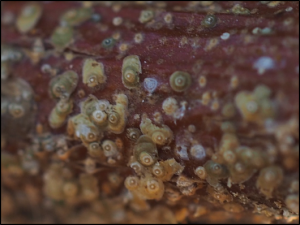
By Clint Thompson
Timing remains a vital part of San Jose scale management for peach producers in the Southeast.
Brett Blaauw, assistant professor at the University of Georgia (UGA) College of Agricultural and Environmental Sciences, outlined the approach growers must take if they are going to successfully manage this pest.

“Getting a good delayed dormant spray on for the scale is our first line of defense. If coming out later you still have issues or if there’s hot spots with San Jose scale, you can come in later in the season, which is usually late April or early May with another insecticide like Movento,” Blaauw said. “We have to have new leaves on the tree as the leaves are what take up Movento, and use a nice spreader sticker or adjuvant to help get that into those leaves is really important, too.”
Timing of Pruning
Blaauw said the initial application often depends on when growers have available time. If they apply oil before pruning, it is usually during January or early February. Producers must increase gallonage to get good coverage (pre-pruned trees have all extra limbs and much more area to cover). If growers wait until later in February after the trees have been pruned, then growers can reduce gallonage to less than 100, because the excess limbs have been taken out.
Blaauw recommends growers start after pruning to reduce amount of oil needed.
“It’s all about labor. If the labor is ready before pruning, try to increase the gallonage. If you have to wait until after pruning, then you can decrease that gallonage. Oil works by suffocating, so you have to get good coverage for it to work,” Blaauw said. “Adding in an insecticide like chlorpyrifos will give you an extra boost, but you still want to get the best bang for your buck with the oil.”
San Jose scale is a tiny insect that has a waxy coating that covers and protects the whole body of the insect. It protects them from the environment and from other insects that would eat them.









